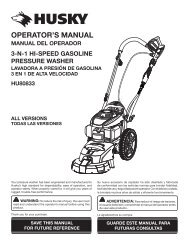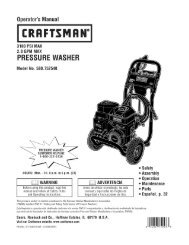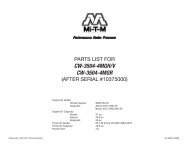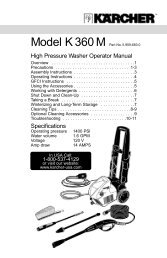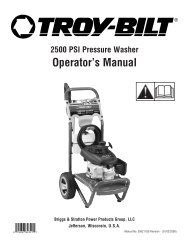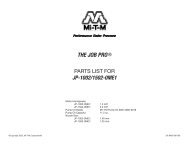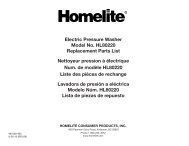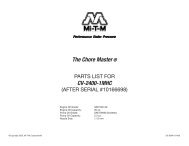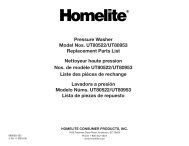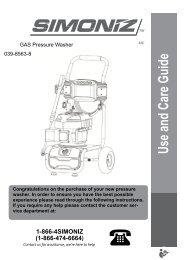I[_i]ADVERTENCJA - Ppe-pressure-washer-parts.com
I[_i]ADVERTENCJA - Ppe-pressure-washer-parts.com
I[_i]ADVERTENCJA - Ppe-pressure-washer-parts.com
Create successful ePaper yourself
Turn your PDF publications into a flip-book with our unique Google optimized e-Paper software.
Attach Hose Reel<br />
Attach hose reel to handle as shown on page 6<br />
according to instruction sheet included with hose reel.<br />
NOTE: There may be small tube adapters included<br />
with the hose reel kit that is not used on this model.<br />
IMPORTANT: You must take the hose off the reel<br />
when operating your <strong>pressure</strong> <strong>washer</strong>. The reel is for<br />
hose storage purposes only.<br />
Attach Chemicam Hose to Pump<br />
Attach chemical hose to chemical<br />
pump.<br />
injection fitting on<br />
1. Use clean, fresh, regular UNLEADED fuel with a<br />
minimum of 77 octane with equipment. DO NOT<br />
use fuel which contains Methanol. DO NOT mix oil<br />
with fuel.<br />
2. Clean area around fuel fill cap, remove cap.<br />
3. Slowly add regular unleaded fuel to fuel tank. Be<br />
careful not to overfill. Allow about 1.5" of tank<br />
space for fuel expansion,<br />
as shown here.<br />
jf<br />
4. Install fuel cap and wipe up any spilled fuel.<br />
Add Engine OH<br />
CAUTION! Any attempt to crank or start the engine<br />
before it has been properly serviced with the<br />
re<strong>com</strong>mended oil may result in an engine failure.<br />
1. Place <strong>pressure</strong> <strong>washer</strong> on a level surface.<br />
2. Clean area around oil fill and remove oil dipstick.<br />
3. Using oil funnel (optional), slowly pour entire<br />
contents of provided oil bottle (18 oz.) into oil fill<br />
opening.<br />
4. Replace oil dipstick and fully tighten.<br />
NOTE: See the section "Oil" on page 18 to review oil<br />
re<strong>com</strong>mendations.<br />
CAUTRON! Alcohol-blended fuels (called gasohol,<br />
ethanol or methanol) can attract moisture, which leads<br />
to separation and formation of acids during storage.<br />
Acidic gas can damage the fuel system of an engine<br />
while in storage.<br />
To avoid engine problems, the fuel system should be<br />
emptied before storage of 30 days or longer. Drain the<br />
fuel tank, start the engine and let it run until the fuel<br />
lines and carburetor are empty. Use fresh fuel next<br />
season. See "Storage" on pages 21-22 for additional<br />
information.<br />
NEVER use engine or carburetor cleaner products in<br />
the fuel tank as permanent damage may occur.<br />
Fresh Start Fuel Cap<br />
Adding fuel preserver helps keep fuel fresh and<br />
carburetors clean for easier starting, all season long.<br />
This new fuel cap automatically drips concentrated<br />
fuel preserver into your fuel tank.<br />
Add<br />
Fuel<br />
NOTE: This gasoline engine is certified to operate on<br />
gasoline. Exhaust Emission Control System: EM<br />
(Engine Modifications).<br />
WARNING<br />
immediately.<br />
WHEN ADDING FUEL<br />
Turn <strong>pressure</strong> <strong>washer</strong> OFF and let it cool at least 2<br />
minutes before removing fuel cap. Loosen cap slowly to<br />
relieve <strong>pressure</strong> in tank.<br />
Fill or drain fuel tank outdoors.<br />
DO NOT overfill tank. Allow space for fuel expansion.<br />
Keep fuel away from sparks, open flames, pilot lights,<br />
heat, and other ignition sources.<br />
DO NOT light a cigarette or smoke.<br />
,6-di-tret-butylpheno{ (128-39-2) and aliphatic<br />
petroleum distillate (64742-47-8)<br />
1. Place cartridge into fuel cap.


![I[_i]ADVERTENCJA - Ppe-pressure-washer-parts.com](https://img.yumpu.com/25458851/8/500x640/i-iadvertencja-ppe-pressure-washer-partscom.jpg)
